Text
Reflection and Evaluation

This year the focus of my practice has been a very personal one, delving into and exploring chronic illnesses. I chose to focus, in particular, on Graves’ Disease, an autoimmune condition that I was diagnosed with 5 years ago. I believe that this topic is particularly significant during the current Covid-19 pandemic. Chronic illness has somewhat come to the forefront during these periods of lockdown, as many of us have experienced feelings of isolation and loneliness, providing us with a small glance and insight into the lives of those suffering from chronic illness whose days are affected in a similar way.
My practice began with a reading of Sick Woman Theory by Johanna Hedva, and mind-mapping my research questions which included: ‘How can illness affect art?”. This particular project largely involved contemporary collage techniques, which is a style that I wouldn’t have typically chosen. However, considering the current restrictions and lockdowns that were in place, this was a technique that I was able to carry out, and develop whilst I was at home in isolation. I primarily used ‘found’ materials including photographs, magazine cuttings, tissue paper and other materials that I had lying around the house. This was ideal as not only did it save me money, but it also linked with my theme of isolation and not being able to go out to access new materials. This, I believe made my final works very organic and even more personal.
I recorded many of my larger collage pieces using the Timelapse function on my iPhone. My reasoning behind these videos, was because I believe the process of collage-making is just as important as the finished piece. I submitted one of these videos as my Exhibition piece for the Christmas Show. These collage pieces were out of my comfort-zone, and I was pushing myself to create these fairly autonomously, so I found these time-lapses a very useful tool to see my progression from a typical “perfectionist” to a much more confident and expressive artist. I also recorded many of my works as photographs, which I shared on my Instagram page @artistfaithamelia. For many of us, Instagram has been of real importance during the Pandemic as a platform to share our works, as well as using it to gain a sense of community. Sharing my work in this way also allowed me to gain feedback from other creatives regarding the direction and effectiveness of my project.
My practice really began to evolve and develop within the last month or two - as previously to this, my pieces were still too ‘pretty’. My inspiration to push myself came from re-visiting my research surrounding Wangechi Mutu, and her use of “beautiful features” to create something quite disturbing. Her work is really powerful and I wanted to push myself to produce messier works that are far more abstract once completed. I decided to shift away slightly, from the original butterfly theme and into more of a medical and abstract direction. This was where my decision came, to produce pen on acetate sketches of diseased thyroids to include and layer within my artwork. April was really when I became to be much more confident in my ability to produce contemporary style collages, developing a much more expressive artistic style.
Due to my choice of materials, I didn’t have to arrange a budget for this project. However, I did have to alter my schedule due to my impending surgery. This meant that I had to bring my project deadlines forward, as I am now restricted in terms of movements during my recovery time. This shorter deadline didn’t affect me too badly, I managed to get it all completed in time, and I think the added time-pressure actually worked in my favour.
I have learned a lot during this project, developing my knowledge of the art world and how I can position myself as a practising artist. I have discovered how to expand my artistic approaches to create much more expressive works. This is a project that I would like to pursue further as a means to continue magnifying my abilities for producing effective art.
1 note
·
View note
Text
Chronos II: Editing/Adding Finishing Touches
I decided that I needed to add some more around the edges of the centre mass, to give more of an illusion of dispersion. So I added some extra pencil sketches, string, tissue paper and hot glue to finish it off. These additional materials around the edges of the initial dense, layered mass, successfully add to this dispersed-illusion.
I am really pleased with this work as my final piece, as I believe it achieves the metamorphosis between the butterfly and the thyroid that I was aiming for. I think the neutral colours against the ageing plywood creates an ambiguous effect, prompting the viewer to ask what is the canvas and what is the artwork?
I also think that this piece has become much more butterfly-like in itself, as it appears to be a floating mass in the centre of blank space.

0 notes
Text
Chronos II
Chronos II is the final exhibition piece of this project exploring Chronic Illness through the use of Contemporary Collage. This piece will be exhibited as a stand-alone piece on the Kunstmatrix platform for the end of year show.

0 notes
Text
New Final Piece: The Making Of Chronos II
These collage pieces were out of my comfort-zone, and I was pushing myself to create these fairly autonomously, so I found these time-lapses a very useful tool to see my progression from a typical “perfectionist” to a much more confident and expressive artist.
0 notes
Text
Development: Planning for Chronos II
The supporting piece will be a simplified version of the original idea, hopefully a work that is more confident in its manifestation as a single piece – it will be of the same scale (4ft x 4ft) to maintain its physicality, and will include one image in the centre of the board.
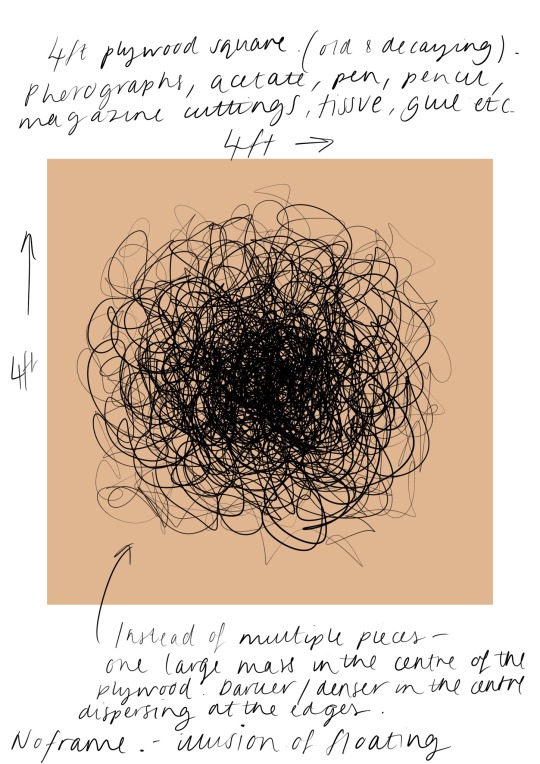
My placements within this collage will be more intentional, as I will be thinking more about form and density. I will be considering how the middle should be darker as it forms a mass, using the idea of dense, solid colours to make this work more physical. I will also be considering the plywood board itself and how I can use the darker shades or nots to push this idea of mass further. This ambiguity between what is the shading of the board and what is the drawing will potentially make a stronger individual work. This idea links fairly well to my research of the opening credits for Spider 2002, in which the video shows damp areas, giving the impression of Rorschach blots, asking us to question whether these are images or natural forms.
I will be bringing more materials into this single piece, including pencil sketches to provide more faded impressions, again finishing this work off with string and other materials as fragmentations around the edges as the mass disperses. This piece will also include hot glue, but my addition of this will be more considered, as the glue within the middle of the original piece is much more effective as it essentially mimics the drawings of the tumours and diseased Thyroids.
Depending on the success of this additional piece, it will potentially be a stand-alone work on the Kunstmatrix platform, with the original piece remaining as the initial body of the work.
0 notes
Text
But You Don’t Look Sick Official: Future Endeavours
Melody Olander, the founder of @ButYouDontLookSickOfficial an Instagram Page, Blog and Website, found my current project on my Instagram account and has asked me to work with her on the Content Creation Team.
@ButYouDontLookSickOfficial is an account that raises awareness for all types of Chronic/Invisible Illnesses. She has over 40k flowers/subscribers and I cannot wait to get continue creating more chronic illness-themed artworks to share on this new platform!
I was already planning on continuing with this project after my university course has finished, as it is such a personal topic and I think that there is still so much scope, and other directions that I could take it, but this opportunity to work for BYDLS is incredible, and will allow me to explore many other chronic illnesses too!

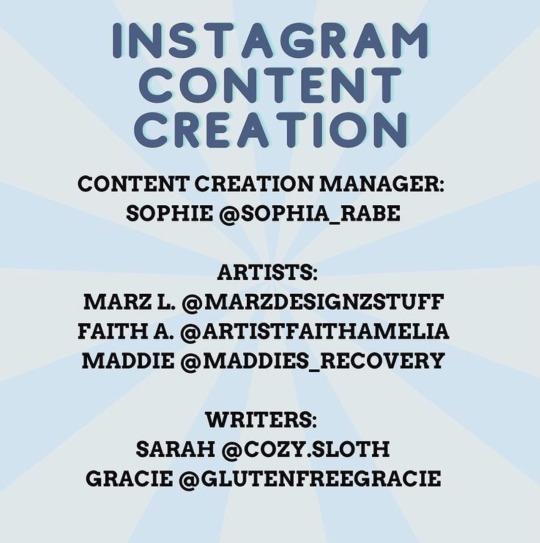
0 notes
Text
Contemporary Collage: Large Centre Piece
The centre image best achieves the sense of metamorphosis between the diseased Thyroids and the butterflies. This image was created directly onto the wooden board, which adds another interesting dimension, and removing the white border that many of the other images include. The plywood has many interesting colourings and markings, and when focusing solely on this centre piece (removing the small images and frames), it becomes something a bit more butterfly-like as it gives the illusion of a ‘mass’ in the middle of the blank space.
For this reason, I have decided to make a new final piece. This supporting piece will be a simplified version of the original idea, hopefully a work that is more confident in its manifestation as a single piece – it will be of the same scale (4ft x 4ft) to maintain its physicality, and will include one image in the centre of the board.

0 notes
Text
Chronos: Evaluating my Final Piece
Since creating this piece intended to be used for the final exhibition, I have spent some time re-evaluating its effectiveness. On initial inspection, I believe that my intentions of ‘recreating’ a museum exhibition have been fairly successful, through my use of framing and titling the works that I have collected and arranged neatly. However, on closer inspection, I am no longer convinced that this is the right solution.

The frames were intended to reference the cases that we see butterflies when we visit museums, and although this piece does reference these fairly successfully, they lack an element of precision, and it remains obvious that this isn’t a cabinet from a museum. Through this realization it has become apparent that the framing and titles are making this particular work try too hard, by asking the viewer to pretend the works are something of which they are not. Although this was an important process to go through, I have come to the conclusion that the framing is now diminishing the overall effect of the art rather than boosting it up to its greatest potential.
Through reflections of this piece, it now almost feels as though it is a final-cut from my sketchbook that has been framed to make it appear as a final exhibition piece. Essentially, the materials used within my final piece should achieve what they are alluding to, and though the artwork itself seems to be successful in achieving this, the frames are making it less convincing overall.
For this reason I have decided to make an additional piece, removing the frames and focusing on what I deem to be the most successful element within this piece – the centre image.
0 notes
Text
Contemporary Collage: Individual Works for Final Piece
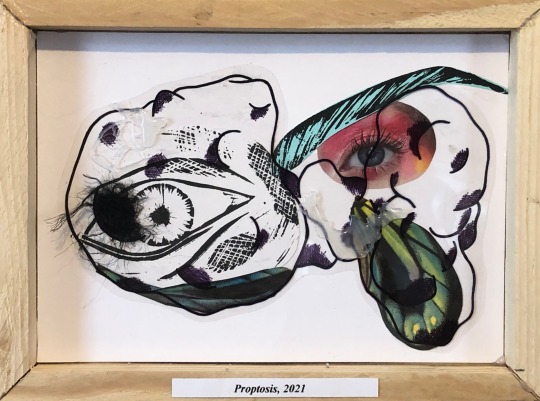
Proptosis - Materials: Lino Prints, Pen on Acetate, Photographs, Magazine Cuttings, String, Hot Glue.
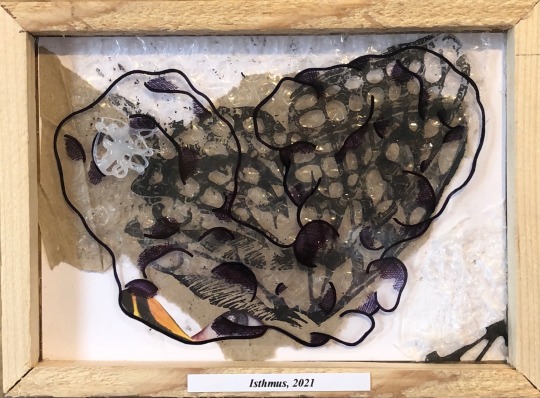
Isthmus - Materials: Lino Prints, Pen on Acetate, Photographs, Magazine Cuttings, Bubble Wrap, Brown Paper, Hot Glue.

Radioactive Iodine Ablation - Materials: Lino Prints, Pen on Acetate, Photographs, Magazine Cuttings, Brown Paper, String, Hot Glue.

Levothyroxine - Materials: Lino Prints on Acetate, Pen on Acetate, Photographs, Magazine Cuttings, String, Hot Glue.

Thyrotoxicosis - Materials: Lino Prints, Pen on Acetate, Photographs, Magazine Cuttings, Paper Bag, String, Tissue Paper, Hot Glue.

Agranulocytosis - Materials: Lino Prints, Pen on Acetate, Photographs, Magazine Cuttings, String, Bubble Wrap, Hot Glue.

Graves’ Ophthalmopathy - Materials: Lino Prints, Pen on Acetate, Photographs, Bubble Wrap, Brown Paper, Paper Bag, String, Hot Glue.

Triiodothyronine - Materials: Lino Prints, Pen on Acetate, Photographs, String, Hot Glue.

0 notes
Text
Lino Printing: Eye Studies
Following on from my pen on acetate sketches, I decided to produce more studies using lino printing, for its boldness and reproducibility. I printed these eye studies into white card, coloured card and acetate.

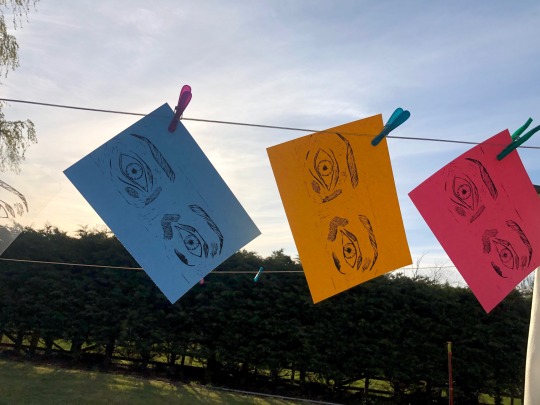


0 notes
Text
Personal Development: Eye sketches
When thinking in more depth about the condition of Graves’ Disease, I realised that I had essentially disregarded the symptoms surround the eyes. I suffer from TED (Thyroid Eye Disease, also known as Graves’ Opthalmopathy), a condition that affects around 30% of those with Graves’ Disease. The immune system attacks the muscles behind the eyes causing them to appear constantly swollen and sore. This is the main symptom that affects me personally on a day-to-day basis. It has caused me to lose a lot of confidence and feel uncomfortable about the way I look.
I wanted to bring this into my final works and so, I produced a series of eye sketches using pen and acetate, as well as a series of Lino-prints. For these studies, I used photographs from when my eyes were at their worst, as well as a photograph of how they are currently.



These studies were a very emotional moment during this project, as I think this was the first time in a long time, that I have properly studied how my eyes now look. It brought up a lot of feelings that I think I had buried for a long time, and although it was a very difficult moment, I believe it was an experience that I needed to go through to fully confront my condition.
0 notes
Text
Project Development: Thyroid Sketches
When reflecting back on the initial pieces for this project, I came to the conclusion that they were still too pretty and I wanted to push past this for my final collages. For this reason, I looked back on the artist research that I completed before Christmas surrounding Wangechi Mutu. Initially I thought that her work was slightly too graphic and so I had disregarded the idea of using this grotesque element within my own work. However, I reevaluated this choice and decided to bring into play a more disturbing element.
Mutu typically uses medical illustrations within her works, but I couldn't find much in the way of thyroid illustrations. So, instead, I used photographs of thyroids that have been removed and used these images to create some pen sketches on acetate.
I chose to draw these onto acetate to enable layering within my future collages. I am really pleased with the abstract effect that I have achieved in these works and will be using these to create my final pieces.


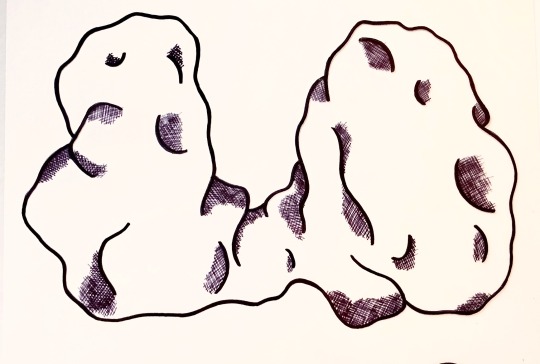
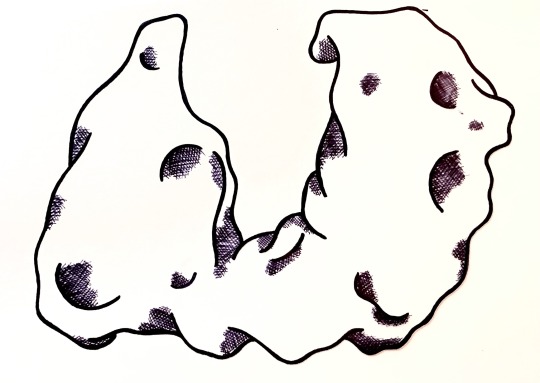
0 notes
Text
Classification Systems: Codex Seraphinianus
When thinking about my work as a reference to butterflies in a museum, it proposes an important question regarding classification. In particular; How am I classifying these images? What system am I using?
As mentioned previously, Jamie Shovlin’s work questions the way in which we map and classify the world around us in order to understand it, and juxtaposes his mother’s view of the world with the scientific theories of Charles Darwin. This juxtaposition allows his work to focus on the issues within our classification systems.
The more that I think about these discrepancies within classification system, I see that it reflects the flaws we see within the medical world too. When we receive a diagnosis, we are told of the common symptoms, and the ways of which most people cope with these. Yet, this experience is different for everyone. It is impossible to group individuals together according to their illness, as it is like.y that they may suffer with different symptoms, or suffer with these to different degrees.

Codex Seraphinianus, is an illustrated encyclopedia created by Italian artist, architect and designer Luigi Serafini. It contains approximately 360 pages illustrating an imaginary world and written in an imaginary language.
The book is divided into two sections (11 chapters in total), with the first section appearing to describe the natural world and the second with various aspects of human (man-made) life. The extreme level of detail and colour and the fact that each chapter seems to address and reflect a general encyclopedic topic, makes these imaginary-beings appear even more believable.
As I am planning to present my final works in a way that resembles a museum, I am going to be titling each individual piece. I haven’t fully decided how I am going to name these hybrid objects that I have created, but at this moment in time I am thinking along the lines of medical terms relating to the condition of Graves’ Disease. This is because many of these terms will be fairly unrecognisable to viewers of my work, unless they have prior-knowledge of the condition.
0 notes
Text
Thinking about final exhibition: Curating ‘Chronos’
Taking inspiration from Jamie Shovlin’s exhibition, for Art Now at the Tate, I have decided to present my final works: a series of small collages, framed and arranged in a methodical way.

Due to not being in the studio, and therefore having no physical wall to display these images, these frames will be mounted onto a 4ft square of plywood intended to resemble a wall. The Plywood I will be using is old and slightly decaying, (it has been in my shed for a long time), which I think will link quite nicely with my theme of diseased organs.
The square format of this final piece also reflects the style of Instagram, which is one of the main platforms that I have been using to share my artworks, particularly during the pandemic. This square piece will fit perfectly within my Instagram feed grid, as well as resembling the Instagram style in real life.
The small collages will be A5 size (21cm x 15cm), as I am striving to use found materials to create this entire project, and A5 card is something that I have readily available to me. I will be making some wooden frames to surround these pieces, to resemble the cases that we see butterflies in museums.
0 notes
Text
Major Project: Documentation/Archiving
I made the decision to document every experimentation throughout this project. This allowed me to decipher which were my most successful pieces and the elements of these that I am going to include within my final collages.
I actually surprised myself with the amount of individual pieces that I have created since the start of this year, and it felt really good to view all of my works as one collective archive.
The lighting and shadows, from the window, that you can see in these photographs are completely unintentional, but I love the effect that these have produced.
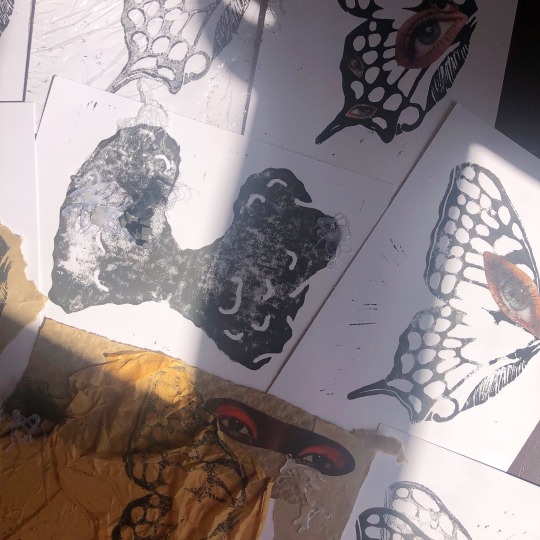






0 notes
Text
“But You Don’t Look Ill” Blog Interview
I took part in an interview with @butyoudontlookill on Instagram opening up about my health conditions, I have attached this interview here:
Name: Faith
Age: 23
Location: Essex, UK
Occupation: Fine Art Student & Small Business owner
What is your illness? And when were you diagnosed? I have Graves’ Disease, Hyperthyroidism and Thyroid Eye Disease and was diagnosed in November 2016. The diagnosis came shortly after my 19th birthday.
How does it affect you day to day? The ways of which my illness affects me varies on a day to day basis - on a good day, I can still function pretty well: with minimal eye strain and headaches and mild fatigue. I think my main struggle is my anxiety. Unfortunately due to my TED, my appearance has changed- causing me to have swollen eyes - this has caused many issues for me throughout the last few years as it makes me extremely uncomfortable with how I feel about myself and I have lost a lot of confidence. I spent a lot of time shut away in my bedroom as I didn’t know how to cope with this. Unfortunately this caused me to lose many friends and miss out on a lot of experiences that I should have gained during the first few years of my 20’s.
What is a bad day like for you? A bad day can sometimes mean that I’m unable to get out of bed, but this is usually when I am struggling with a bad flare-up. Most bad days mean that I can function, but I am extremely fatigued, and usually experience anxiety, overheating, palpitations, shaky hands, migraines, and I struggle with a swollen neck and puffy eyes.
I am coping much better health-wise currently, and am pleased to say that I’m having many more good days than bad, which on the whole is great, but it does mean that the bad days can sometimes feel even worse.
Have you ever had a ‘but you don’t look ill’ experience? If so tell me about it... Honestly, so many times. Before I was diagnosed, I went to my GP multiple times because I was experiencing chronic headaches, which essentially made me black out, and I would lose hours of each day. My GP told me that there was nothing wrong and that I should just put the headaches down to stress as they came at the same time as my a level exams and my move to Brighton to start my degree. It wasn’t until I went back around a month or 2 later with swollen eyes that they sent me for urgent blood tests and I got my diagnosis.
I often get told that I’m ‘not old enough’ to be unwell, and that I am ‘very lucky’ to have a condition that means I dint have to watch my weight.
I’m a very active person, I enjoy running and working out, and I think that this causes some confusion amongst others when I say that I’m unwell. But, As long as I am having a ‘good day’, I will exercise, I will walk my dog, I will paint, and draw and see friends - I am not going to let my illness stop me from living my best life any longer.
How has your life changed since diagnosis? I had just moved to Brighton to begin my degree, and unfortunately due to my health, I had to drop out of University and move home. Initially, I didn’t cope very well with my diagnosis, and essentially became a bit of a hermit - I felt embarrassed and self-conscious and felt as though it was easier to cope simply being shut away at home.
Once I had gotten over the initial shock of my diagnosis, I knew I had to do something to keep me occupied. I wasn’t well enough to go back to my studies or to get a full-time job, so I started up my own little business painting textile items. This gave me a reason to get out of bed in the morning & keep my mind busy, which I am so so thankful for.
I re-applied for a university course in 2018 and am pleased to say that I will be graduating within the next few weeks.
My health issues have certainly given me a new outlook on life, and though it has caused many difficulties, it has allowed me to always be so appreciative and see the beauty in the smallest of things.
What would you say to someone newly diagnosed? Listen to your body. I knew there was something that wasn’t quite right, and if I had been more expressive of this to my GP, I may have been diagnosed earlier. I think I would also remind them that it is totally okay to not know how you feel about it. Obviously it is such a huge moment for anyone to be told that they have a lifelong condition and I think it is totally acceptable to feel upset and grieve for who you were before.
Definitely do your research regarding the condition that you will have for the rest of your life, but know when to stop. I got totally fixated and wanted to learn everything I could about my condition and honestly, I don’t think it helped at all. Symptoms differ from person to person and I think that is another key thing that you need to remember.
Most importantly, remember that whilst your illness is a part of you, it does not define you.
What is one thing you wish people knew about your illness? There is no cure. I will have Graves’ Disease for the rest of my life - though I am due to have my thyroid removed next week, this is no quick fix. It will certainly alleviate some symptoms, but my autoimmune condition will always affect me.
0 notes
Text
Collage Experimentations: Attempting to Push the Boundaries and Become ‘Messier’
I found that I was still restricting myself too much within my collage works, and so I began to try pushing these boundaries further. I decided to bring in some images of eyes from magazines, as Graves’ Disease can sometimes affect the appearance and movement of them. Though messy, the glue is still too neat and confined and I think that the butterfly wings are still too full and recognisable. I really enjoyed creating these pieces and am fairly happy with my use of layering, but I still think that I can produce messier works that are far more abstract once completed.
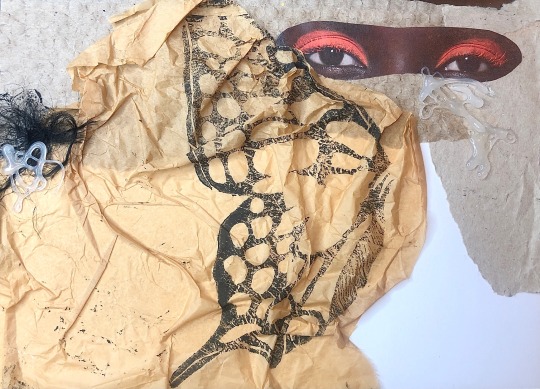
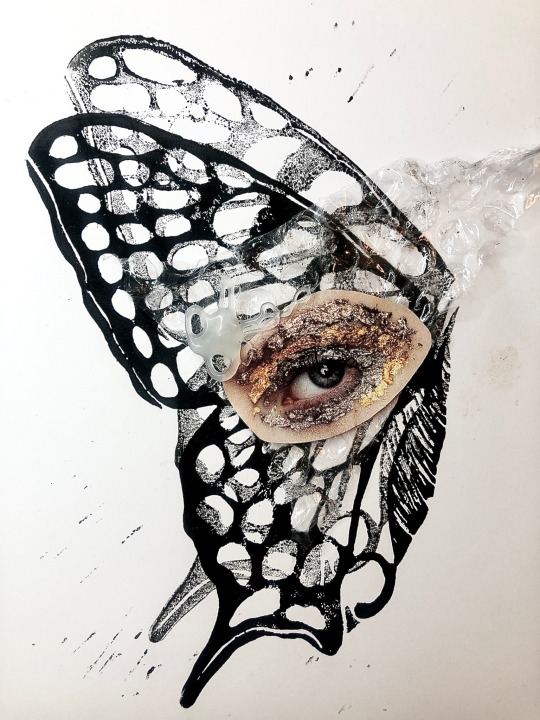


0 notes